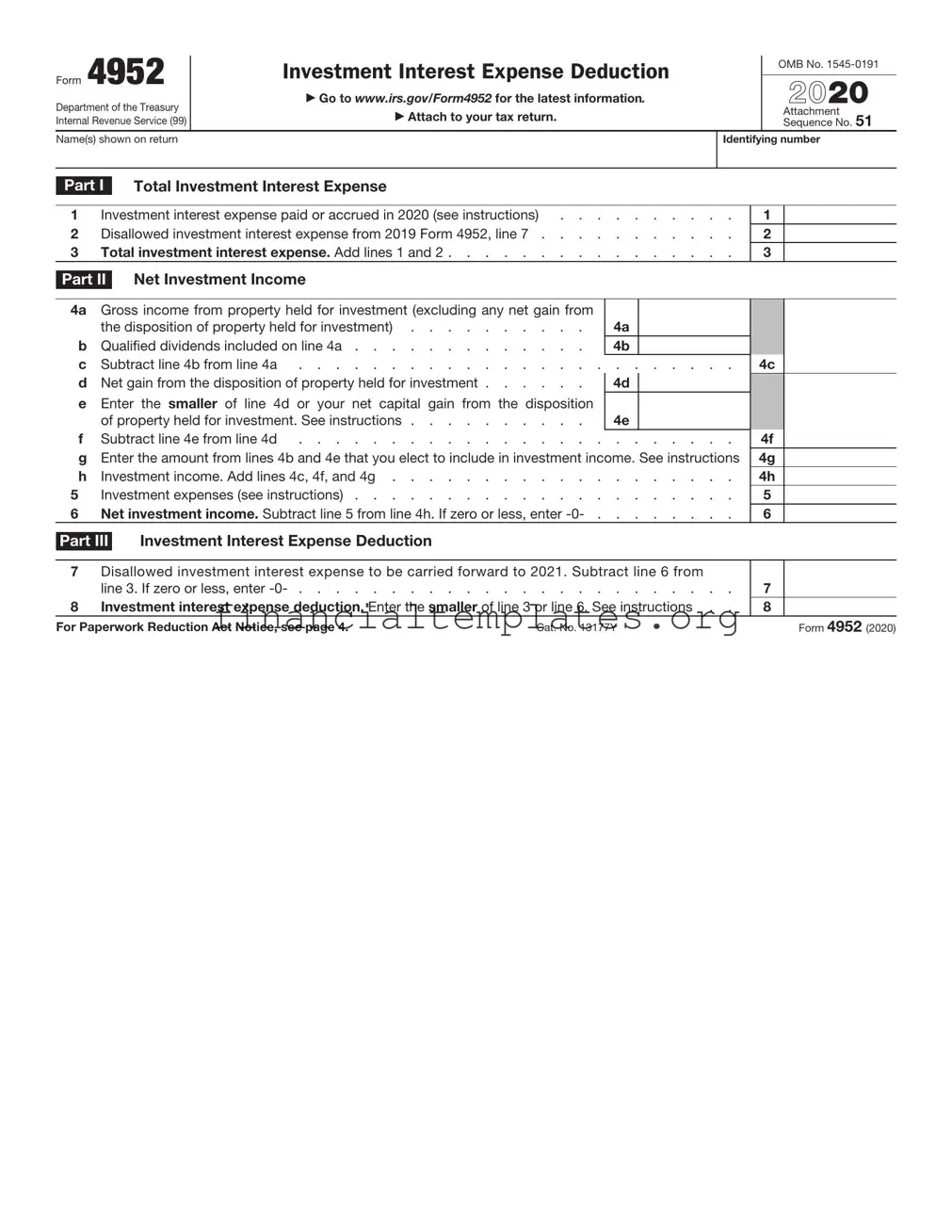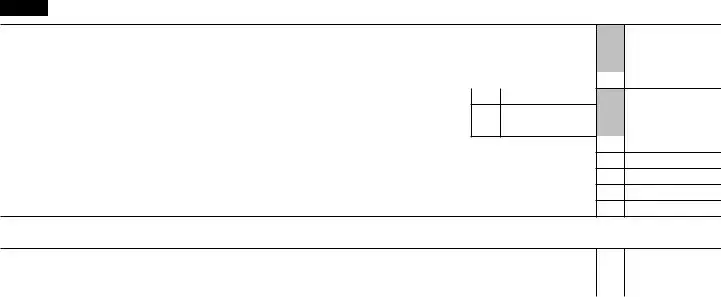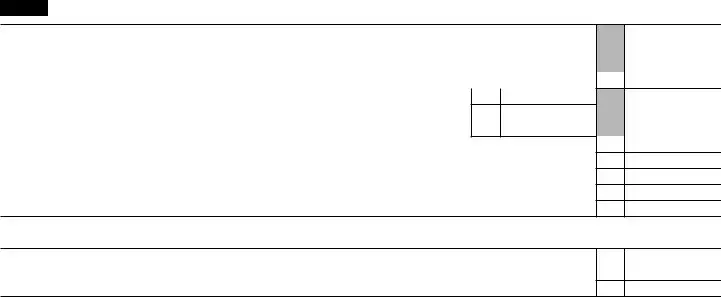Section references are to the Internal Revenue Code unless otherwise noted.
Future Developments
For the latest information about developments related to Form 4952 and its instructions, such as legislation enacted after they were published, go to www.irs.gov/Form4952.
General Instructions
Purpose of Form
Use Form 4952 to figure the amount of investment interest expense you can deduct for 2021 and the amount you can carry forward to future years. Your investment interest expense deduction is limited to your net investment income.
For more information, see Pub. 550, Investment Income and Expenses.
Who Must File
If you are an individual, estate, or a trust, you must file Form 4952 to claim a deduction for your investment interest expense.
Exception. You don’t have to file Form 4952 if all of the following apply.
•Your investment income from interest and ordinary dividends minus any qualified dividends is more than your investment interest expense.
•You don’t have any other deductible investment expenses.
•You don’t have any carryover of disallowed investment interest expense from 2020.
Allocation of Interest Expense
If you paid or accrued interest on a loan and used the loan proceeds for more than one purpose, you may have to allocate the interest. This is necessary because different rules apply to investment interest, personal interest, trade or business interest, home mortgage interest, and passive activity interest. See Pub. 535, Business Expenses.
Specific Instructions
Part I—Total Investment Interest Expense
Line 1
Enter the investment interest expense paid or accrued during the tax year, regardless of when you incurred the indebtedness. Investment interest expense is interest paid or accrued on a loan or part of a loan that is allocable to property held for investment (as defined later).
Include investment interest expense reported to you on Schedule K-1 from a partnership or an S corporation. Include amortization of bond premium on taxable bonds purchased after October 22, 1986, but before January 1, 1988, unless you elected to offset amortizable bond premium against the interest payments on the bond. A taxable bond is a bond on which the interest is includible in gross income.
Investment interest expense doesn’t include any of the following.
•Personal interest under section 163(h), including qualified residence interest.
•Interest expense that is properly allocable to a passive activity. Generally, a passive activity is any trade or business activity in which you don’t materially participate and any rental activity. See the Instructions for Form 8582, Passive Activity Loss Limitations, for details.
•Any interest expense that is capitalized, such as construction interest subject to section 263A.
•Interest expense related to tax-exempt interest income under
section 265.
•Interest expense, disallowed under section 264, on indebtedness with respect to life insurance, endowment, or annuity contracts issued after June 8, 1997, even if the proceeds were used to purchase any property held for investment.
Property held for investment. Property held for investment includes property that produces income, not derived in the ordinary course of a trade or business, from interest, dividends, annuities, or royalties. It also includes property that produces gain or loss, not derived in the ordinary course of a trade or business, from the disposition of property that produces these types of income or is held for investment. However, it doesn’t include an interest in a passive activity.
Exception. A working interest in an oil or gas property that you held directly or through an entity that didn’t limit your liability is property held for investment, but only if you didn’t materially participate in the activity.
Part II—Net Investment Income
Line 4a
Gross income from property held for investment includes income, unless derived in the ordinary course of a trade or business, from interest, ordinary dividends (except Alaska Permanent Fund dividends), annuities, and royalties. Include investment income reported to you on Schedule K-1 from a partnership or an S corporation. Also include net investment income from an estate or a trust.
Also include on line 4a (or 4d, if applicable) net passive income from a passive activity of a publicly traded partnership (as defined in section 469(k)(2)). See Regulations sections 1.469-10 and 1.7704-1 (including the transition rule of section 1.7704-1(l)) for details.
Net income from certain passive activities, such as rental of substantially nondepreciable property, may have to be recharacterized and included on line 4a. For details, see Pub. 925, Passive Activity and At-Risk Rules, or Regulations section 1.469-2(f)(10).
If you are filing Form 8814, Parents’ Election To Report Child’s Interest and Dividends, part or all of your child’s income may be included on line 4a. See the instructions for Form 8814 and Pub. 550 for details.
|
Don’t include on line 4a any net gain from the disposition of |
▲ |
! |
property held for investment. Instead, enter it on line 4d. |
CAUTION |
|
Line 4b
Enter the portion of ordinary dividends included on line 4a that are qualified dividends. For the definition of qualified dividends, see the instructions for Form 1040, line 3a (or Form 1041, line 2b).
Line 4d
Net gain from the disposition of property held for investment is the excess, if any, of your total gains over your total losses from the disposition of property held for investment. When figuring this amount, include capital gain distributions from mutual funds and capital loss carryovers.
Line 4e
Net capital gain from the disposition of property held for investment is the excess, if any, of your net long-term capital gain over your net short- term capital loss from the disposition of property held for investment.
Capital gain distributions from mutual funds are treated as long-term capital gains.
Note: If line 4e is more than zero and you enter an amount on line 4g, see the Note in the line 4g instructions, later.
Line 4g
In general, qualified dividends and net capital gain from the disposition of property held for investment are excluded from investment income. But you can elect to include part or all of these amounts in investment income.
The qualified dividends and net capital gain that you elect to ▲! include in investment income on line 4g aren’t eligible to be
taxed at the qualified dividends or capital gains tax rates. CAUTION You should consider the tax effect of using the qualified
dividends and capital gains tax rates before making this election. Once made, the election can be revoked only with IRS consent.
To make the election, enter on line 4g the amount you elect to include in investment income (don’t enter more than the sum of lines 4b and 4e). Also enter this amount on whichever of the following applies.
•The Schedule D Tax Worksheet, line 3.
•Schedule D (Form 1041), line 25.
•The Qualified Dividends Tax Worksheet, line 3, in the Instructions for Form 1041.
If you file Form 1040 or 1040-SR and enter an amount on TIP line 4g, use the Schedule D Tax Worksheet in the
Instructions for Schedule D (Form 1040) to figure the amount to enter on Form 1040 or 1040-SR, line 16. If you file Form



